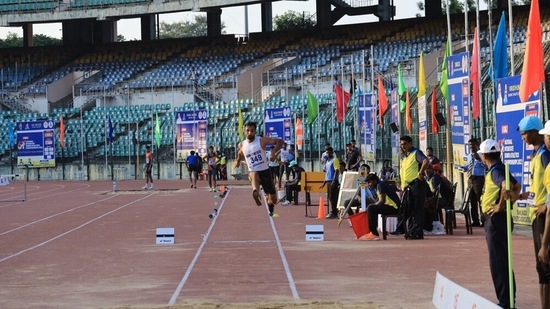The big leap: India's jumpers are moving into a new orbit
Three Indians attained the qualifying mark for the upcoming World Champions in the long jump and the triple jump.
It has been an extraordinary season for Indian jumpers. Never before had three long jumpers and three triple jumpers in the men's section attained the qualifying for the World Championships.

That’s the maximum quota per country in the worlds, scheduled in Oregon from July 15-24, and Indian jumpers have sealed it all. However, the Athletics Federation of India (AFI) first dropped long jumper Jeswin Aldrin from the squad, saying his performance was in 'decline' and then did a volte-face by asking him to appear for selection trials.
Aldrin was also not picked for the Commonwealth Games in a season when the 20-year-old had a personal best of 8.26m and a wind-aided 8.37m. In fact he went past 8m in three competitions this year, but in his last four meetings he did not touch the mark. Now Aldrin will have to jump close to 8.10m on July 4 to be considered for selection.
Only time will tell what is in store for the youngster, but it does not take away the fact that Aldrin has played a big role in raising the level this season. Both Aldrin and Sreeshankar achieved the Worlds qualification standard of 8.22m, while Muhammed Anees Yahiya made the cut for world championships through world rankings.
In the triple jump, Abdulla Aboobacker and Praveen Chithravel surpassed the entry standard of 17.14m, and Eldhose Paul's consistency saw him qualify via world rankings. Another jumper Karthik Unnikrishnan was close to the qualifying mark, with his personal best leap of 17.10m at the Indian Grand Prix in May.
“What we are seeing in jumps in India is world class,” says S Murali, father and coach of Sreeshankar.
“Three long jumpers doing 8 metres consistently and then there are some inching closer to 8m is something that has never happened before. In triple jumps, you have three athletes going past the 17m mark and one almost close to 17m. It is rare,” says Murali, a former triple jumper himself.
The domestic season has seen fierce competition among the jumpers, pushing each other on the field. Before this season, only two triple jumpers -- Renjith Maheswary and Arpinder Singh – had crossed the 17m barrier. The national record is with Maheswary (17.30m).
But that is likely to be erased sooner rather than later, the way Aboobacker, Chithravel, Paul and Karthik have stepped up. Three of them have gone past 17m this year. At the Indian Grand Prix in Bhubaneshwar, Aboobacker's gold medal winning effort was 17.19m, while Karthik jumped 17.10m. In Inter-state Championships this month, Chithravel set a new meet record of 17.18m and Abdulla finished second with 17.14m.
“This is a very good time for triple jumpers,” says assistant India coach Hari Krishnan, also a former international.
“The quality has gone up. They know if they don't do 17m, they won’t even win in India. There is a healthy competition. They are almost of the same age group and coming up together. They are friends and help each other,” says Krishnan.
Krishnan, who has competed till 2016, was a Services coach where he groomed Abdulla, Paul and Karthik since 2018.
“It is not a sudden performance but a gradual progress. It is very technical. I made changes in their technique and in the first year there was little improvement. In the last couple of seasons they have jumped bigger and they have the capability to do much better,” he says.
The competition helps
Sreeshankar, who qualified for the Tokyo Olympics, has certainly made a big difference. He first crossed 8m in 2018 and since then has only improved. It has spurred Aldrin and Anees who gave him tough competition at home this year.
“When you have good competitors, it pushes you to give your best,” says Anees.
“I enjoy competing with Sree and Aldrin. It motivates when you see them cheering. More competitions abroad will help us in giving better performances in big meets,” added Anees, who jumped 8.04m at Qosanov Memorial in Almaty recently.
Murali says one of the factors behind the performance of this young bunch is coaches who are constantly updating themselves and giving their best.
“We have some very good Indian coaches who are young, and eager to learn. Today, so much information is available online. Everyone is reading and updating themselves. They are making a difference,” he said. “In my time, we used to over train. What I have done with Sreeshankar is that I have not given him unnecessary load. I never give him two sessions continuously. There is more focus on quality work, rest and recovery. We cannot survive doing the American way of training. Their physique is different. Most coaches are following new training methods to extract the best from the jumpers.”
All Access.
One Subscription.
Get 360° coverage—from daily headlines
to 100 year archives.



HT App & Website







